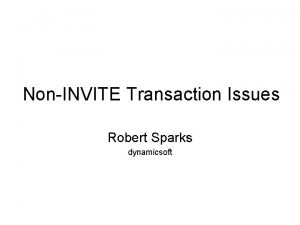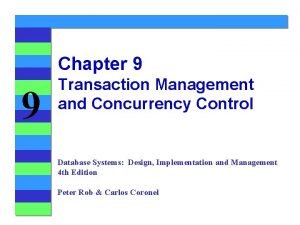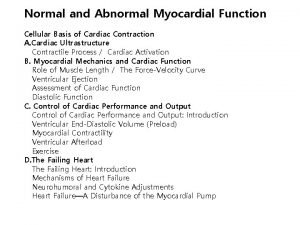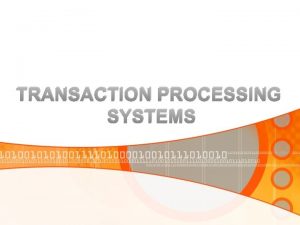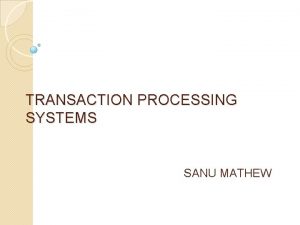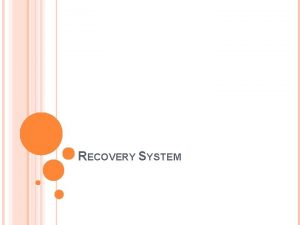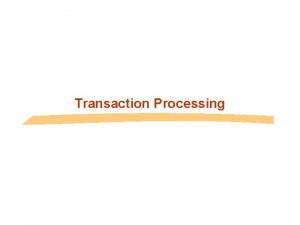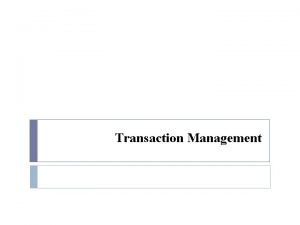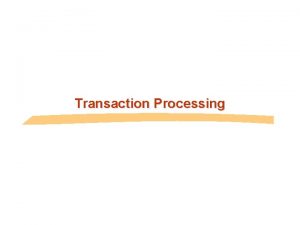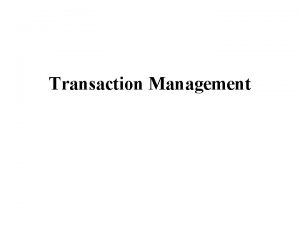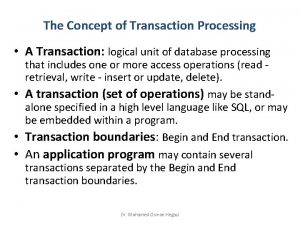Recovery System Failure Classification Transaction failure Logical errors












- Slides: 12

Recovery System

Failure Classification • Transaction failure : – Logical errors: transaction cannot complete due to some internal error condition – System errors: the database system must terminate an active transaction due to an error condition (e. g. , deadlock) • System crash: a power failure or other hardware or software failure causes the system to crash. – Fail-stop assumption: non-volatile storage contents are assumed to not be corrupted by system crash • Database systems have numerous integrity checks to prevent corruption of disk data • Disk failure: a head crash or similar disk failure destroys all or part of disk storage – Destruction is assumed to be detectable: disk drives use checksums to detect failures

Recovery Algorithms • Recovery algorithms are techniques to ensure database consistency and transaction atomicity and durability despite failures – Focus of this chapter • Recovery algorithms have two parts 1. Actions taken during normal transaction processing to ensure enough information exists to recover from failures 2. Actions taken after a failure to recover the database contents to a state that ensures atomicity, consistency and durability

Recovery and Atomicity (Cont. ) • To ensure atomicity despite failures, we first output information describing the modifications to stable storage without modifying the database itself. • We study two approaches: – log-based recovery, and – shadow-paging • We assume (initially) that transactions run serially, that is, one after the other.

Log-Based Recovery • A log is kept on stable storage. – The log is a sequence of log records, and maintains a record of update activities on the database. • When transaction Ti starts, it registers itself by writing a <Ti start>log record • Before Ti executes write(X), a log record <Ti, X, V 1, V 2> is written, where V 1 is the value of X before the write, and V 2 is the value to be written to X. – Log record notes that Ti has performed a write on data item Xj Xj had value V 1 before the write, and will have value V 2 after the write. • When Ti finishes it last statement, the log record <Ti commit> is written. • We assume for now that log records are written directly to stable storage (that is, they are not buffered) • Two approaches using logs – Deferred database modification – Immediate database modification

Deferred Database Modification • The deferred database modification scheme records all modifications to the log, but defers all the writes to after partial commit. • Assume that transactions execute serially • Transaction starts by writing <Ti start> record to log. • A write(X) operation results in a log record <T , X, V> being written, where V is the new value for X i – Note: old value is not needed for this scheme • The write is not performed on X at this time, but is deferred. • When Ti partially commits, <Ti commit> is written to the log • Finally, the log records are read and used to actually execute the previously deferred writes.

Deferred Database Modification (Cont. ) • During recovery after a crash, a transaction needs to be redone if and only if both <Ti start> and<Ti commit> are there in the log. • Redoing a transaction Ti ( redo. Ti) sets the value of all data items updated by the transaction to the new values. • Crashes can occur while – the transaction is executing the original updates, or – while recovery action is being taken • example transactions T 0 and T 1 (T 0 executes before T 1): T 0: read (A) T 1 : read (C) A: - A - 50 C: - C- 100 Write (A) write (C) read (B) B: - B + 50 write (B)

Deferred Database Modification (Cont. ) • Below we show the log as it appears at three instances of time. • If log on stable storage at time of crash is as in case: (a) No redo actions need to be taken (b) redo(T 0) must be performed since <T 0 commit> is present (c) redo(T 0) must be performed followed by redo(T 1) since <T 0 commit> and <Ti commit> are present

Immediate Database Modification • The immediate database modification scheme allows database updates of an uncommitted transaction to be made as the writes are issued – since undoing may be needed, update logs must have both old value and new value • Update log record must be written before database item is written – We assume that the log record is output directly to stable storage – Can be extended to postpone log record output, so long as prior to execution of an output(B) operation for a data block B, all log records corresponding to items B must be flushed to stable storage • Output of updated blocks can take place at any time before or after transaction commit • Order in which blocks are output can be different from the order in which they are written.

Immediate Database Modification Example Log Write <T 0 start> <T 0, A, 1000, 950> To, B, 2000, 2050 <T 0 commit> <T 1 start> x <T 1, C, 700, 600> 1 A = 950 B = 2050 C = 600 <T 1 commit> • Output Note: BX denotes block containing X. BB, BC BA

Shadow Paging • Shadow paging is an alternative to log-based recovery; this scheme is useful if transactions execute serially • Idea: maintain two page tables during the lifetime of a transaction –the current page table, and the shadow page table • Store the shadow page table in nonvolatile storage, such that state of the database prior to transaction execution may be recovered. – Shadow page table is never modified during execution • To start with, both the page tables are identical. Only current page table is used for data item accesses during execution of the transaction. • Whenever any page is about to be written for the first time – A copy of this page is made onto an unused page. – The current page table is then made to point to the copy – The update is performed on the copy

Example of Shadow Paging Shadow and current page tables after write to page 4
 Non-invite transaction failure
Non-invite transaction failure Transaction recovery in distributed systems
Transaction recovery in distributed systems Transaction management and concurrency control
Transaction management and concurrency control Logical operators equivalence
Logical operators equivalence Logical equivalence in discrete mathematics
Logical equivalence in discrete mathematics Failure to sense
Failure to sense Failure to capture vs failure to sense
Failure to capture vs failure to sense Cup and cone fracture ductile or brittle
Cup and cone fracture ductile or brittle Interactive input
Interactive input Lvedp normal range
Lvedp normal range Types of information systems
Types of information systems Transaction processing system
Transaction processing system Transaction processing systems examples
Transaction processing systems examples
